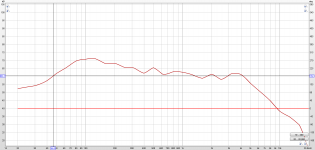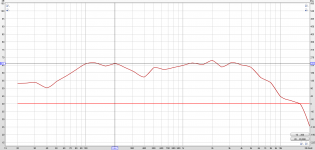I went out and bought the IMM-6 mic and Audiotool app for android. I wanted to test my bass cab for frequency response in a simulated real world environment so I just set it up in the living room and set the mic/phone 3' away on axis with the center line of the cab. Horizontal and Vertical center line that is.
Playing bass live, you're on stage with two guitars and a drummer. There are reflective surfaces everywhere and lots of absorptive matter, so I figure the living room is kind of the best place. Kind of.
Here are two graphs, pink and white noise. I did not include a sweep.
What seems to be happening here?
Playing bass live, you're on stage with two guitars and a drummer. There are reflective surfaces everywhere and lots of absorptive matter, so I figure the living room is kind of the best place. Kind of.
Here are two graphs, pink and white noise. I did not include a sweep.
What seems to be happening here?
Attachments
Last edited:
It's an Eminence 3015 woofer and Alpha 6a midrange.
BTW this a great sounding bass cab, very smooth through the midrange with just enough top end.
BTW this a great sounding bass cab, very smooth through the midrange with just enough top end.
Is it normal for the pink noise and white noise to be so different?
Which one could be considered the more accurate of the two?
Which one could be considered the more accurate of the two?
ahh i see.... there is a difference between pink and white noise in that pink rolls off 3db per octave while white noise is equal across the entire bandwidth.
don't get caught up in the which is better or more accurate type of thinking or you may miss the importance of both are analysis tools and used together can be more useful then one versus the other.
pink is considered a closer approximation to what spectral distribution we humans like.
rather than introduce my personal biases here a little more reading for you White Noise Definition Vs. Pink Noise – Acoustic Fields
don't get caught up in the which is better or more accurate type of thinking or you may miss the importance of both are analysis tools and used together can be more useful then one versus the other.
pink is considered a closer approximation to what spectral distribution we humans like.
rather than introduce my personal biases here a little more reading for you White Noise Definition Vs. Pink Noise – Acoustic Fields
sorry i missed answering your first question...to me the two graphs are not so different both tell me your cab shows a range of response that between 100 and 4k doesn't vary by greater than 8 db across that bandwidth so all in all pretty flat for a musical instrument cab.
what are you using for a head with this cab?
what are you using for a head with this cab?
Last edited:
sorry i missed answering your first question...to me the two graphs are not so different both tell me your cab shows a range of response that between 100 and 4k doesn't vary by greater than 8 db across that bandwidth so all in all pretty flat for a musical instrument cab.
what are you using for a head with this cab?
It's a Mesa D800+. A class D amp ICE power.
are you familiar with how to use the cursors in your Audiotool app?
No, not yet. It's new to me.
i earlier estimated the response variation as 8 db but it's closer to 10 possibly 12 db of variation.
that's what the cursor lines are for, line up at the lowest point on the curve, read the value move the cursor to the highest point on the response line read the value (within the bandwidth ei range of interest) then subtract the two values and voila response variation in all too confusing DB!
the vertical cursor gives frequency values which makes it easy to use both horz & vert aligned to a specific point to give exact values as X db @ Y hz.
that's what the cursor lines are for, line up at the lowest point on the curve, read the value move the cursor to the highest point on the response line read the value (within the bandwidth ei range of interest) then subtract the two values and voila response variation in all too confusing DB!
the vertical cursor gives frequency values which makes it easy to use both horz & vert aligned to a specific point to give exact values as X db @ Y hz.
- Home
- Loudspeakers
- Multi-Way
- Audiotool

